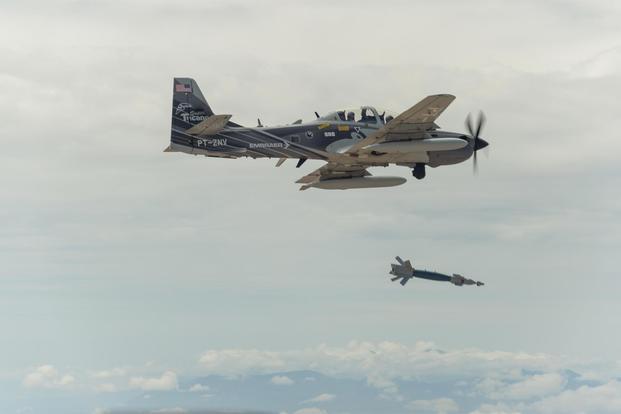The U.S. Air Force has issued its official request for proposal to acquire a small fleet of turboprop aircraft as part of its light attack effort.
The service wants a limited number of Textron Aviation AT-6 Wolverine and Sierra Nevada Corporation/Embraer Defense & Security A-29 Super Tucano aircraft to increase "partner capacity, capability, and interoperability via training and experimentation," officials said in a news release Friday.
A contract award is expected before year's end for the A-29, and in early 2020 for the AT-6.
"Our focus is on how a light attack aircraft can help our allies and partners as they confront violent extremism and conduct operations within their borders," Air Force Chief of Staff Gen. David Goldfein said in the release. "Continuing this experiment, using the authorities Congress has provided, gives us the opportunity to put a small number of aircraft through the paces and work with partner nations on ways in which smaller, affordable aircraft like these can support their air forces."
Related: Air Force to Procure 'Small Number' of Light Attack Aircraft
The Air Force plans to purchase two or three light attack aircraft from each company, a decision Goldfein first disclosed in March.
He told the Senate Appropriations defense subcommittee during a hearing at the time that the service would base some of the aircraft at Nellis Air Force Base, Nevada, and some with Air Force Special Operations Command (AFSOC) at Hurlburt Field, Florida.
The AT-6 will be used by Air Combat Command at Nellis "for continued testing and development of operational tactics and standards for exportable, tactical networks that improve interoperability with international partners," the service said Friday. The A-29, meanwhile, will be housed at Hurlburt "to develop an instructor pilot program for the Combat Aviation Advisory mission, to meet increased partner nation requests for light attack assistance."
The Air Force has been on a path to double the number of combat aviation advisers it sends to train partners on special operations missions, planning for a total of 352 force integration advisers over the next few years. AFSOC members who are part of the elite unit -- and who already work with Super Tucano light attack aircraft and Pilatus PC-12NG planes, among other models -- told Military.com last year that the service's light attack endeavor could fit within their mission.
The Air Force announced in 2016 that it had plans to hold flight demonstrations with a handful of aircraft to test whether lighter, less expensive and off-the-shelf aircraft might be usable in combat zones such as Afghanistan. The service first held a series of light attack experimental fly-offs and maneuvers at Holloman Air Force Base, New Mexico, in 2017 in a two-phase approach. The second phase of the experiment was canceled following a fatal crash in June 2018.
Even with the second phase cut short, Air Force officials have said the Wolverine and Super Tucano are the best fits for its light attack needs.
Goldfein on Friday also said the Air Force intends to continue experimentation to explore "a common architecture and intelligence-sharing network" that can connect platforms, sensors and weapons. "If I hear one thing from my international air chiefs, it's 'we need to figure out how to share information both ways," he said.
In the past, Goldfein has described light attack as a "network approach" to share intelligence between partners.
The Pentagon in early July asked Congress to reallocate funds to give an extra boost to its light attack aircraft effort -- also known as OA-X -- by shifting unspent money to the program, combining a total of $156.73 million from its fiscal 2018 and 2019 budgets to continue light attack experimentation, and potentially obligate the spending toward the handful of aircraft.
Gen. Mike Holmes, head of Air Combat Command, said in September that additional experimentation could get the attention of partners and allies that may want to participate in the program, or even to expand their current inventory of light attack aircraft in an affordable and useful way.
Much like the F-35 Joint Strike Fighter program, a larger network of partners within the Light Attack program would aid in driving down costs and sustainment down the road, Holmes said during the annual Air Force Association Air, Space and Cyber conference.
"We have to continue to experiment and work through and find the right piece of kit, the right piece of capability," Holmes told reporters during a roundtable discussion.
His comments came days after Rep. Michael Waltz, R-Florida, introduced a measure into the House's version of the fiscal 2020 National Defense Authorization Act legislation that would put the propeller-driven planes under U.S. Special Operations Command's purview, taking it away from the Air Force.
"My frustration is almost palpable at why it is taking so long to get this platform out to where the warfighters need it," Waltz said during a Mitchell Institute event, as reported by DefenseOne. "If we can't move this program forward, then perhaps we need to explore if the Army needs that authority," he said.
Holmes said the push-pull conversation is typical for any budget proceedings.
"Like any program that we would take on, we have to prioritize within the topline budget that we have," he said, addressing questions about Waltz's concerns.
"We're not walking away from it," Holmes said. "We're working through to make sure we continue to do our best to understand that capability and where we can use it and where we couldn't."
-- Oriana Pawlyk can be reached at oriana.pawlyk@military.com. Follow her on Twitter at @Oriana0214.
Read more: Colonel Released from Brig as Child's Family Denounces Military Provision That Freed Him












